
Phyllota is an Australian genus from the family Fabaceae, a biological grouping of flowering plants.

Aotus is an Australian genus of flowering plants, within the legume family Fabaceae. Aotus species, together with other species of the tribe Mirbelieae, are often called golden peas because of their distinctive small yellow flowers. They are endemic to Australia, occurring in all states except the Northern Territory. Aotus are evergreen species. Some are widely cultivated by gardeners for their ornamental value.
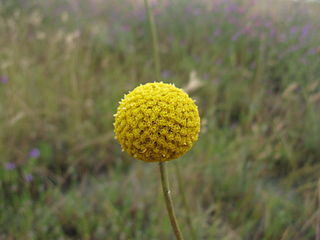
Pycnosorus is a genus of six species of plants in the family Asteraceae. Commonly known as billy buttons or drumsticks, they are annual or perennial herbs or small shrubs with a cylindrical to spherical head of up to 200 daisy-like "flowers". Each "flower" is a pseudanthium consisting of between three and eight florets surrounded by bracts. The petals are joined to form a small tube and the florets with their surrounding bracts are yellow or golden-yellow.

Olearia, most commonly known as daisy-bush, is a genus of flowering plants belonging to the family Asteraceae, the largest of the flowering plant families in the world. Olearia are found in Australia, New Guinea and New Zealand. The genus includes herbaceous plants, shrubs and small trees. The latter are unusual among the Asteraceae and are called tree daisies in New Zealand. All bear the familiar daisy-like composite flowerheads in white, pink, mauve or purple.
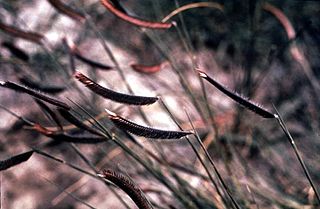
Bouteloua gracilis, the blue grama, is a long-lived, warm-season (C4) perennial grass, native to North America.

Bouteloua is a genus of plants in the grass family. Members of the genus are commonly known as grama grass.

Swainsona is a large genus of flowering plants native to Australasia. There are 85 species, all but one of which is endemic to Australia.
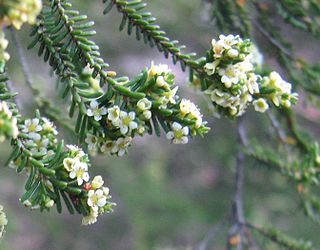
Micromyrtus is a genus of shrubs, in the family Myrtaceae, described as a genus in 1865. The entire genus is endemic to Australia.

Calocephalus is a genus of flowering plants in the family Asteraceae. It is endemic to Australia, where it is represented in every state.

Eurybia compacta, commonly known as the slender aster, is an herbaceous perennial native to the eastern United States from New Jersey to Georgia. It is commonly found along the coastal plain in dry sandy soils, especially in pinelands. While it is not considered to be in high danger of extinction, it is of conservation concern and has most likely been extirpated from much of its original range. The slender aster was for a long time considered to be a variety of E. surculosa, but Guy Nesom's recent research within the genus has shown that it is distinct enough to be treated as a species. It has also been shown to be related to E. avita and E. paludosa.

Calytrix is a genus of shrubs in the family Myrtaceae described as a genus in 1806. They are commonly known as starflowers. Calytrix are endemic to Australia, occurring in the.
Helianthus niveus is a species of sunflower known by the common names showy sunflower and snowy sunflower. It is native to northern Mexico and the Southwestern United States.
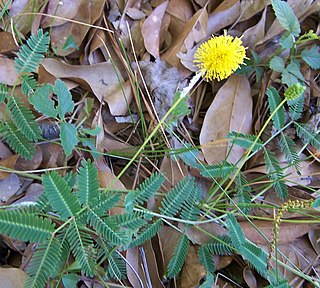
Neptunia is a genus of flowering plants in the family Fabaceae. It belongs to the mimosoid clade of the subfamily Caesalpinioideae.
Camptacra is a genus of flowering plants in the family Asteraceae.
Pleurocarpaea is a genus of Australian plants in the evil tribe within the daisy family.

Aphelia is a genus of plants in the Restionaceae family. The entire genus is endemic to Australia. APG III system classifies this genus in the Centrolepidaceae family.

Pollia is a genus of flowering plants in the Commelinaceae, first described in 1781. It is widespread through the Old World Tropics: Africa, southern Asia, northern Australia, etc. There is also one species endemic to Panama.
Arnica gracilis is a North American species of flowering plant in the family Asteraceae, known by the common name smallhead arnica. It is native to western Canada and the northwestern United States (Washington, Oregon, Idaho, Montana, Wyoming, north-central Colorado, and northern Utah.
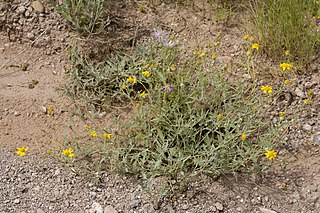
Bahia absinthifolia, the hairyseed bahia or desert bahia, is a North American species of flowering plants in the family Asteraceae. It is native to northern Mexico and the south-western United States.

Olearia muelleri is a plant in the Asteraceae family. It was first described as Eurybia muelleri in 1853 by Otto Wilhelm Sonder. In 1867, George Bentham assigned it to the genus Olearia in his Flora Australiensis.















